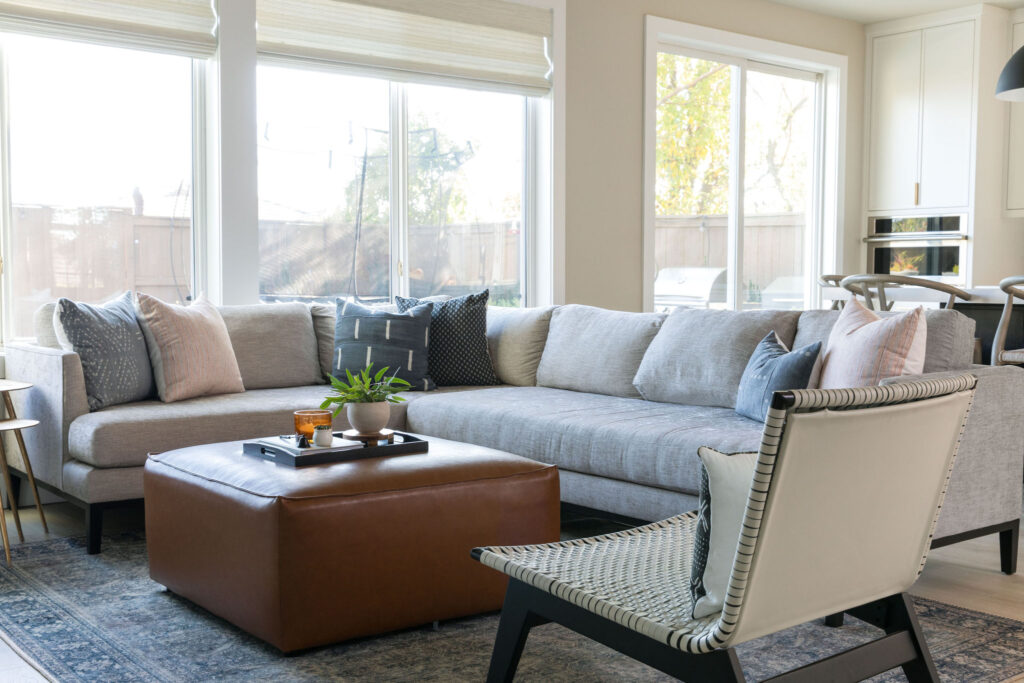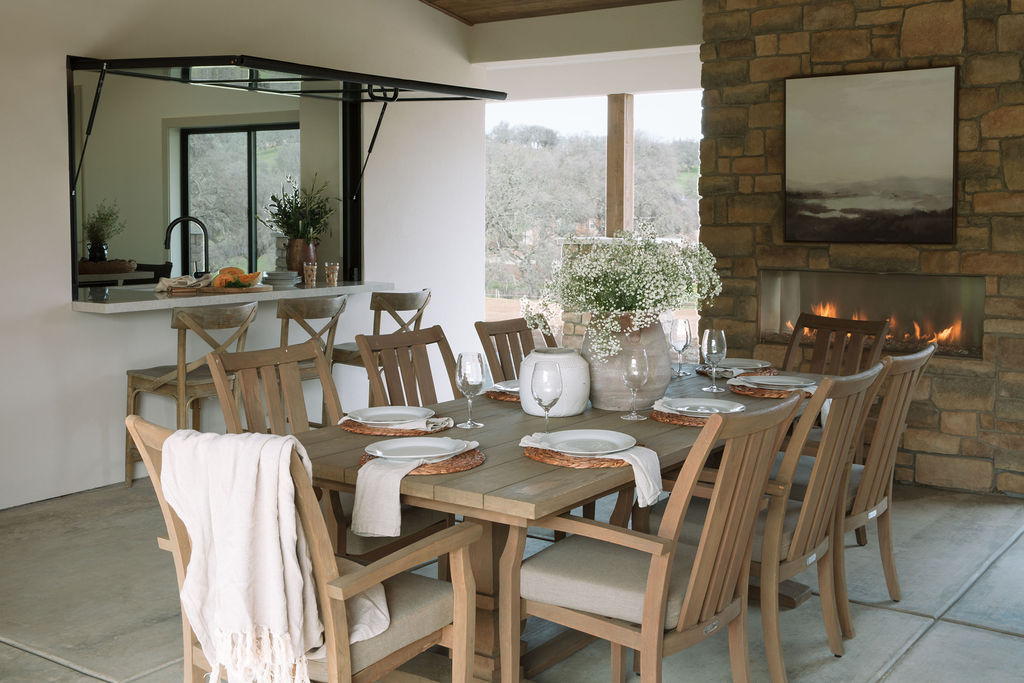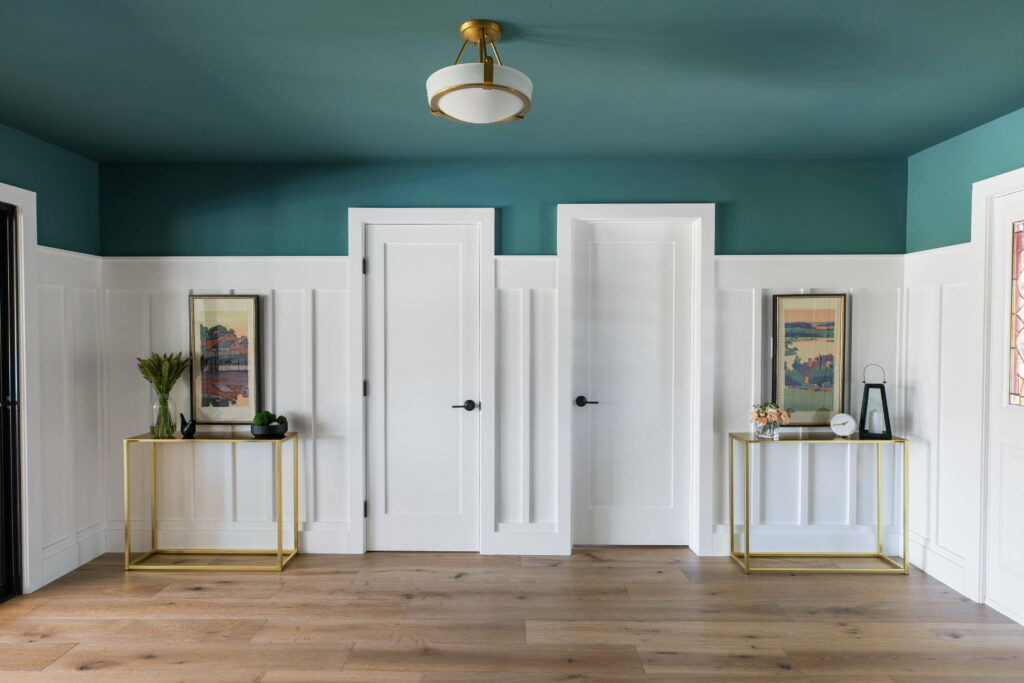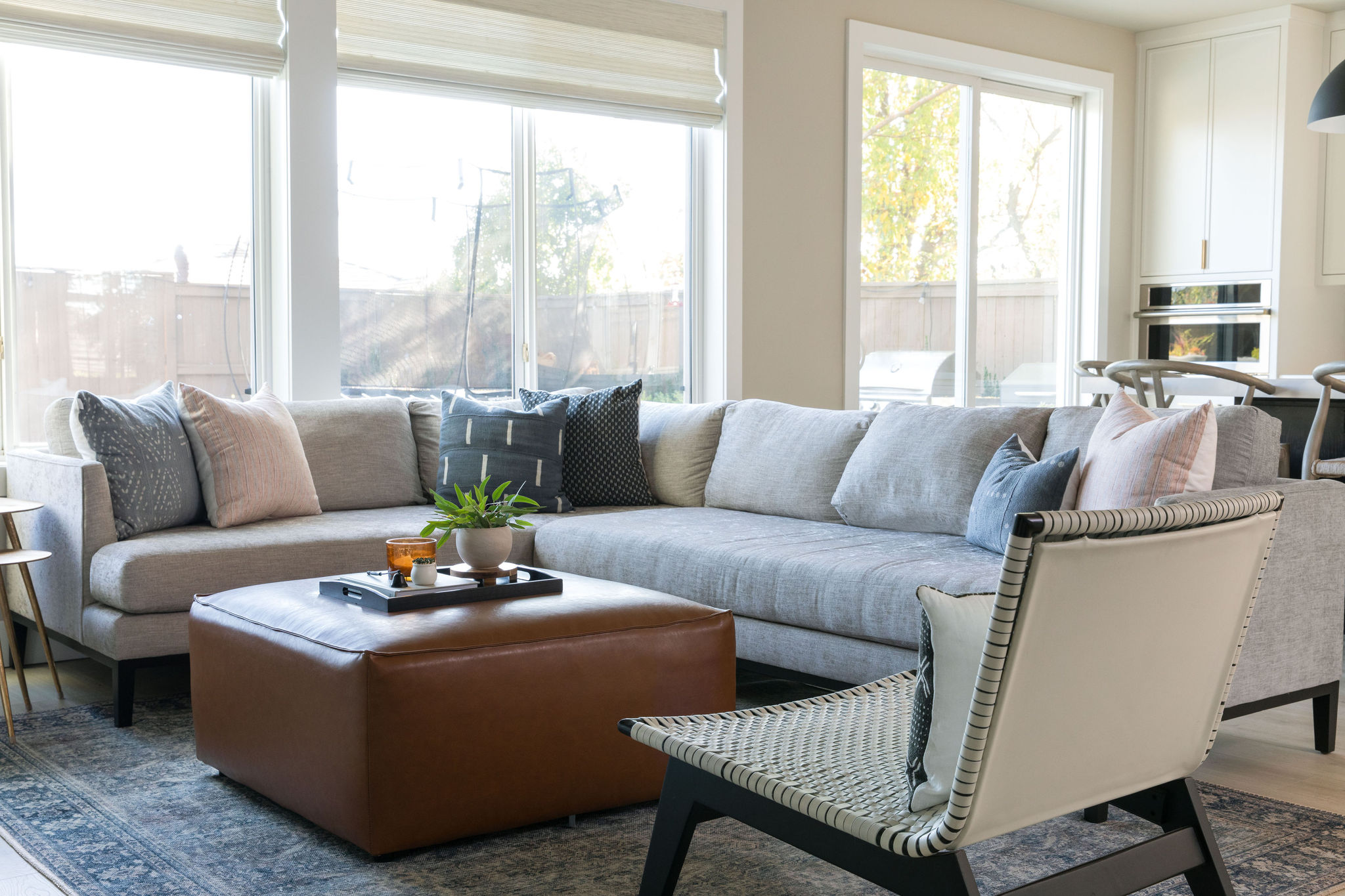Ever felt like your home’s interior design color schemes are stuck in a beige limbo? Or maybe you’ve gone wild with a rainbow explosion that would make a unicorn blush? Don’t worry—finding the perfect colors for your home is a challenge that stumps even the most creative folks. It’s like trying to solve a Rubik’s Cube blindfolded while riding a unicycle. Tricky, right?
But here’s the good news: interior designers have cracked the color code, and we’re here to spill the beans. We’re not hoarding secret paint swatches or consulting crystal balls (although that would be pretty cool). Instead, we’re using time-tested techniques and a dash of creative magic to transform houses into homes that sing with color.
So, what’s our secret sauce for picking out colors that make your space pop without looking like a crayon factory explosion? How do we balance bold statements with subtle harmony? And most importantly, how can you learn to do it, too?
We’re pulling back the curtain on the colorful world of interior design. We’ll unravel the mystery of color palettes versus color schemes, explore popular interior design color combinations, and share insider tips on finding your perfect palette. By the time you finish reading, you’ll be ready to wield your paintbrush with confidence–or know exactly when to call in the pros.
Ready to add some color to your life (and walls)? Let’s dive into the vibrant world of interior design colors!

What’s the difference between color palette and scheme?
Before we dive into the deep end of the color pool, let’s get our terminology straight. You’ve probably heard the terms “color palette” and “color scheme” tossed around like confetti at a paint party. But what do they actually mean? Are they just fancy designer lingo, or is there a real difference? Spoiler alert: There is!
Color palette: Your personal color playlist
Think of a color palette as your home’s personal color playlist. It’s the collection of colors you choose to use throughout your space. Just like your music playlist might include a mix of upbeat pop, soulful jazz, and maybe a dash of heavy metal, your color palette includes all the colors you’ll use in your home.
Your palette might include main colors, accent colors, and neutrals. It’s unique to you and your space, reflecting your personal style, the mood you want to create, and even the architectural features of your home. It’s the big picture of your home’s color story.
Interior design color schemes: The rhythm of your colors
Now, if the color palette is your playlist, think of the color scheme as the specific way you arrange those colors to create harmony (or intentional contrast). It’s like the difference between having a bunch of great songs and knowing how to DJ them into a killer set.
Color schemes are based on color theory and the relationships between different hues on the color wheel. They give you a framework for combining colors in ways that are pleasing to the eye and create the atmosphere you’re after. Whether you’re going for calm and serene or bold and energetic, there’s a color scheme to help you get there.
Why understanding the difference matters
“Okay,” you might be thinking, “but why should I care about the difference?” Great question! Understanding the distinction between palette and scheme is like having a map and compass for your color journey.
Your palette gives you the colors to work with, while your scheme tells you how to use them effectively. This knowledge helps you:
- Create a cohesive look throughout your home
- Avoid the “I just threw random colors at the wall,” look
- Confidently combine colors in ways that enhance your space
- Communicate more effectively with design professionals
So, now that we’ve got our color vocabulary sorted, are you ready to explore some popular interior design color schemes? Trust us, it’s about to get even more colorful!
Interior design color schemes
Now that we’ve got our color lingo sorted let’s dive into the exciting world of color schemes. Think of these as the secret recipes interior designers use to whip up visually delicious spaces. Each scheme has its own flavor, and knowing when to use them is like having a well-stocked spice rack for your home’s palette.

Monochromatic interior design color schemes
Imagine your favorite color taking center stage and singing all the parts. That’s a monochromatic scheme for you! It uses different shades, tones, and tints of a single color.
Examples:
- Fifty shades of blue (way more interesting than grey, if you ask us!)
- Variations of warm terracotta from light to deep
Pros:
- Creates a harmonious, cohesive look
- Makes small spaces feel larger
- Easy to put together—it’s hard to clash with yourself!
Cons:
- Can feel bland if not done right
- Might lack visual interest without careful use of texture and pattern
Analogous interior design color schemes
This scheme uses colors that are next to each other on the color wheel. It’s like inviting colors over for a block party—they all get along swimmingly!
Examples:
- Blue, blue-green, and green
- Yellow, yellow-orange, and orange
Pros:
- Creates a serene, comfortable atmosphere
- Offers more variety than monochromatic without the risk of clashing
- Easy on the eyes—nature uses this scheme a lot!
Cons:
- Can lack contrast if not balanced well
- Might feel “too safe” for those craving more excitement

Complementary interior design color schemes
This scheme pairs colors from opposite sides of the color wheel. It’s bold, it’s daring, it’s like mixing fire and ice!
Examples:
- Blue and orange
- Purple and yellow
Pros:
- Creates high contrast and visual interest
- Makes both colors pop
- Energetic and lively
Cons:
- Can be overwhelming if not balanced properly
- Tricky to get right – it’s a fine line between vibrant and chaotic
Triadic interior design color schemes
This scheme uses three colors equally spaced around the color wheel. It’s like forming a color superhero team!
Examples:
- Red, yellow, and blue
- Purple, green, and orange
Pros:
- Offers rich color contrast
- Provides balance and harmony
- Versatile – can be bold or subtle depending on the shades used
Cons:
- Can be tricky to balance
- Might be too colorful for some tastes
Split-Complementary interior design color schemes
This scheme takes one color and pairs it with the two colors adjacent to its complement. It’s like the complementary scheme, but with backup dancers!
Examples:
- Blue with yellow-orange and red-orange
- Purple with yellow-green and yellow-orange
Pros:
- Offers high contrast like a complementary scheme, but with more nuance
- Easier to balance than a complementary scheme
- Provides a good mix of warm and cool tones
Cons:
- Can be challenging to get the balance right
- Might be too complex for some spaces
Remember, these interior design color schemes aren’t rigid rules – they’re more like guidelines to help you create harmonious color combinations. The key is experimenting and finding what works best for your space and style.
How to find your color palette
Now that we’ve explored the map of color schemes, it’s time to embark on a quest to discover your perfect color palette. Don’t worry; this journey won’t require any Indiana Jones-style peril – just a bit of self-reflection and some savvy tips from your friendly neighborhood interior designers.
Consider your personal style and preferences
First things first – what makes you tick? Are you a minimalist who swoons over sleek, monochromatic spaces? Or are you more of a maximalist who believes “more is more” when it comes to color? Your personal style is the compass that’ll guide your color choices, so take some time to think about what you truly love.
Pro tip: Create a Pinterest board or Instagram collection of interiors that make your heart sing. You’ll likely notice some color patterns emerging!
Look at your existing furniture and artwork
Unless you’re starting from scratch (lucky you!), you’ll want your new color palette to play nice with your existing pieces. Take a good look at the colors in your furniture, rugs, and artwork. These can serve as a jumping-off point for your palette – think of them as the soloists, and you’re choosing the backup singers.
Think about the mood you want to create
Colors aren’t just pretty – they’re powerful mood-setters. Want a calm, serene bedroom? Soft blues and greens might be your jam. Craving an energetic, creative home office? Maybe it’s time to flirt with some vibrant yellows or oranges. Choose colors that align with the vibe you’re after in each space.
Consider the function of each room
Your home gym probably wants a different color treatment than your meditation nook. Think about how you use each space and let that inform your color choices. High-energy areas can handle bolder colors, while spaces for relaxation might benefit from a softer touch.
Use the 60-30-10 rule
Here’s a nifty designer trick: divide your color palette into primary, secondary, and accent colors. Use your primary color for about 60% of the space (think walls and large furniture), your secondary color for 30% (curtains, rugs), and your accent color for the remaining 10% (pillows, artwork). It’s like the golden ratio, but for color!
Test before committing
Before you go all in on “Passionate Plum” for your living room, take it for a test drive. Here’s how:
- Color swatches: Paint large swatches on your wall and live with them for a few days. See how they look in different lights and at different times of day.
- Digital tools and apps: Many paint companies offer apps that let you virtually paint your room. It’s like time travel, but for decorating!
Finding your perfect color palette is a journey, not a destination. It’s okay to experiment, make mistakes, and change your mind. The goal is to create a space that feels like you–whether that’s calm and collected or bold and beautiful.

Color tips from interior design pros
It’s time to pull back the curtain and reveal some insider secrets! These are the tricks we interior designers keep up our sleeves (along with our color wheels and fabric swatches). Consider this your VIP pass to the world of professional color selection!
Start with a neutral base
Think of neutrals as the perfect backup singers – they support the star colors without stealing the show. A neutral base gives you flexibility to play with color accents and makes it easier to switch things up when you’re in the mood for change. But remember, “neutral” doesn’t have to mean “boring” – think warm greys, soft taupes, or even muted blues.
Pro tip: If you’re color-shy, start with a mostly neutral room and add pops of color through accessories. It’s like dipping your toe in the color pool before diving in!
Use the color wheel
That color wheel from your elementary school art class? It’s about to become your new best friend. Use it to find complementary colors for a bold look or analogous colors for a more harmonious feel. It’s like having a cheat sheet for color combinations!
Consider lighting and how it affects color
Here’s a fun fact: colors can be chameleons! That “Perfect Peach” paint can look vastly different under natural daylight, warm incandescent bulbs, or cool LED lighting. Always test colors in the actual space and under different lighting conditions (i.e., distinct times of day and various bulb temperatures) before committing.
Read More>> Why is Kitchen Lighting so Hard to Get Right and How to Fix it
Designer secret: North-facing rooms tend to get cooler, bluer light, while south-facing rooms get warmer light. Keep this in mind when choosing your colors, as the quality of light will impact the way the color looks.
Don’t forget about texture and patterns
Color isn’t just about, well, color. Texture and pattern play a huge role in how we perceive color in a space. A rich velvet sofa will make a color feel more luxurious, while a rough linen might make the same color feel more casual. Use texture and pattern to add depth and interest to your interior design color scheme. Ultimately, the best way to use texture and pattern to enhance your color scheme is to experiment and see what works best for you. There are no hard and fast rules, so don’t be afraid to get creative!
Be mindful of color psychology
Colors can affect our mood and behavior more than we realize. While personal associations matter most, here are some general guidelines:
- Blues and greens tend to be calming (perfect for bedrooms or bathrooms)
- Reds and oranges are energizing (great for dining rooms or exercise spaces)
- Yellows can be cheerful but also anxiety-inducing in large doses
- Purples often feel luxurious and creative
Remember, these aren’t hard and fast rules – if a color makes you happy, use it!
Ready to paint your home?
You’ve just completed your crash course in the art of color selection. From understanding the difference between interior design color palettes and color schemes to avoiding common color pitfalls, you’re now armed with the knowledge to make confident color choices for your home.
Remember, choosing colors for your home is more than just picking pretty hues – it’s about creating an atmosphere that reflects your personality and enhances your daily life. Whether you’re going for a calm oasis or a vibrant, energizing space, the right colors can help you achieve your vision.
Speaking of space, if you’re dealing with smaller rooms or just want to create an airier feel, you might wonder about the best colors. Good news! We’ve got you covered. Check out our article for expert tips on using color to expand your space visually.
At Jennifer Ramsey Interiors, we’re passionate about helping you create a home that’s as unique and vibrant as you are. Whether you’re ready to dive into a bold new color scheme or just need a little guidance on choosing the perfect shade of “greige,” we’re here to help.
Contact us, and let’s work together to bring your color dreams to life. We’ll help you navigate the world of color, lighting, and space planning to create a home that’s beautiful and perfectly yours.
Remember, in the world of interior design, you’re the artist, and your home is the canvas. So grab your metaphorical paintbrush, and let’s create something beautiful together!
